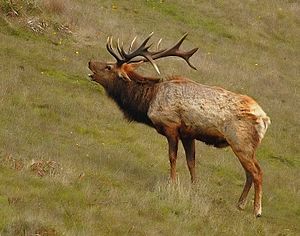Tule elk facts for kids
Quick facts for kids Tule elk |
|
|---|---|
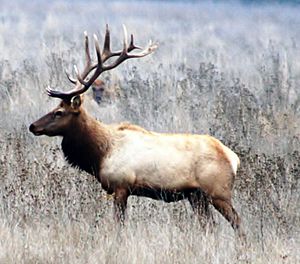 |
|
| Tule bull elk at San Luis National Wildlife Refuge, courtesy of Bill Leikam | |
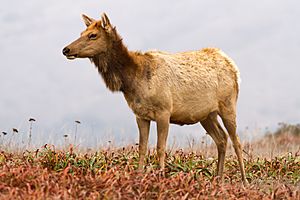 |
|
| Tule cow elk at Tomales Point, Point Reyes National Seashore | |
| Scientific classification |
|
| Kingdom: | Animalia |
| Phylum: | Chordata |
| Class: | Mammalia |
| Order: | Artiodactyla |
| Family: | Cervidae |
| Subfamily: | Cervinae |
| Genus: | Cervus |
| Species: | |
| Subspecies: |
C. c. nannodes
|
| Trinomial name | |
| Cervus canadensis nannodes (Merriam, 1905)
|
|
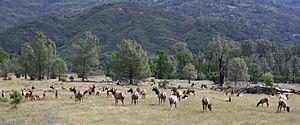
The tule elk (Cervus canadensis nannodes) is a special type of Elk that lives only in California. You can find them in places like the grassy areas and marshlands of the Central Valley, and also in the hills along the coast. Their name comes from the tule plant, which is a type of sedge that grows in freshwater marshes. Tule elk love to eat this plant.
Long ago, when Europeans first arrived, about 500,000 tule elk lived here. But by 1870, almost all of them were gone. Luckily, in 1874–1875, people found just one breeding pair in the tule marshes near Buena Vista Lake. Thanks to special efforts to protect them in the 1970s, there are now over 4,000 tule elk living in the wild! You can often spot them in places like Carrizo Plain National Monument, Point Reyes National Seashore, parts of the Owens Valley, and on Coyote Ridge near San Jose, California.
Contents
What Do Tule Elk Look Like?
Tule elk are known as the smallest type of wapiti (another name for elk) in North America. Before the Spanish arrived, they were the main large grazing animal in California. Adult male tule elk usually weigh between 450 to 550 pounds (204 to 249 kg). Females are a bit smaller, weighing about 375 to 425 pounds (170 to 193 kg).
Sometimes, people call them "dwarf elk" because they can be smaller than other elk. However, some tule elk can grow quite large, especially if they have plenty of good food. For example, some male elk on Grizzly Island have weighed up to 900 pounds (408 kg)! This is similar to the size of Roosevelt elk.
Baby tule elk, called calves, look a lot like deer fawns. They have brown fur with white spots. Scientists have studied their DNA and confirmed that Tule elk are a unique subspecies, different from Roosevelt elk and Rocky Mountain elk.
A Look Back: Tule Elk History
The first European who might have seen tule elk was Francis Drake in 1579. He wrote about seeing "thousands" of very large deer in California. Later, in 1595, another explorer named Sebastian Rodriguez Cermeño definitely saw them. He described huge elk antlers, with one measuring 11 feet from tip to tip!
When the Spanish came in the late 1700s, they brought cattle and horses. These animals ate the same grasses as the elk, which meant less food for the elk. People also hunted the elk without limits. By 1873, when elk hunting was finally banned, most people thought the tule elk were completely gone.
Saving the Tule Elk
Luckily, a cattle rancher named Henry Miller helped save the tule elk. In 1874, a game warden found a pair of elk on Miller's ranch near Buena Vista Lake. Miller ordered his workers to protect them. Because of him, the subspecies survived!
After Miller passed away, his ranch was divided up, and hunting started again. The number of elk dropped to only 72. By 1895, there were only 28 left due to loss of their homes and poaching (illegal hunting). Many attempts to move these elk to new places failed.
In 1933, a rancher named Walter Dow took a small group of elk to his ranch in Owens Valley. Even though it wasn't their original home, the elk did very well there.
Modern Conservation Efforts
In the 1960s and 1970s, people started working harder to protect the tule elk. A woman named Beula Edmiston from Los Angeles formed a group to help. After more than 10 years of working with the government, California passed a law in 1971. This law said that tule elk could not be hunted until their numbers reached over 2,000 statewide. It also told the state to bring elk back to their old habitats whenever possible.
In 1976, the U.S. Congress also agreed that having 2,000 tule elk was a good goal. They told federal agencies to make land available for the elk. Many groups worked together to find new homes for the elk. Herds were started in places like the San Luis Wildlife Refuge, Concord Naval Weapons Station, Mount Hamilton, Lake Pillsbury, Point Reyes National Seashore, and other areas.
Where Do Tule Elk Live Now?
Long ago, tule elk lived north of the San Francisco Bay in places like Sonoma and Marin County.
Thanks to successful programs to bring them back, the number of tule elk grew. By 1986, there were over 2,000 elk in 22 different groups across California. By 2019, the total population in California was estimated to be around 5,700!
What Do Tule Elk Eat?
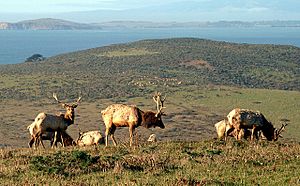
In 1978, ten tule elk were moved to Tomales Point at Point Reyes National Seashore. At first, they had some health problems, possibly because of a lack of copper in their diet or dry weather. But by 1981, they started having babies at a normal rate.
Studies show that tule elk mostly eat grasses and forbs (small flowering plants). They don't eat many shrubs like willow. This is similar to what elk eat in other areas, where more than half of their diet is grass.
A study in 2007 at the Tomales Point Elk Reserve found that tule elk are very important for keeping grasslands healthy. When elk graze, they help prevent open grasslands from turning into areas dominated by shrubs. Their grazing also helps native grassland plants grow better and increases the variety of plants. They even help reduce a problem grass called Holcus lanatus, which can take over grasslands.
Learning About Tule Elk
If you're interested in learning more, the Environmental Science Department at De Anza College in Cupertino, California offers a course. This class lets students observe tule elk in Santa Clara County, California. It teaches about the history of bringing the elk back, where they live, what they do, and other interesting facts. It also talks about the challenges and successes of saving this unique California animal. The class includes field trips to see the elk herds in person!


